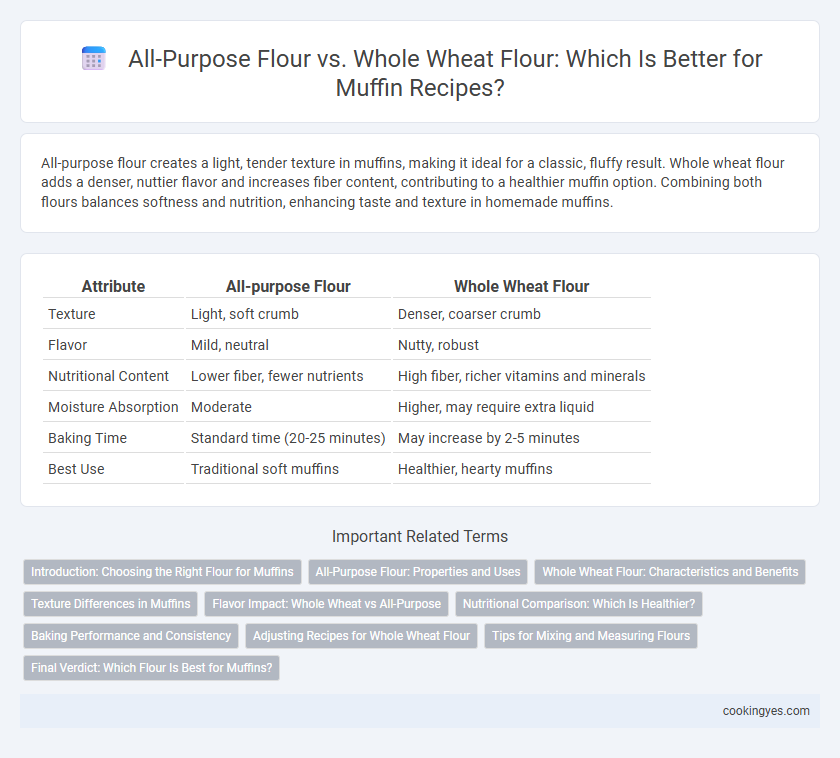All-purpose flour creates a light, tender texture in muffins, making it ideal for a classic, fluffy result. Whole wheat flour adds a denser, nuttier flavor and increases fiber content, contributing to a healthier muffin option. Combining both flours balances softness and nutrition, enhancing taste and texture in homemade muffins.
Table of Comparison
| Attribute | All-purpose Flour | Whole Wheat Flour |
|---|---|---|
| Texture | Light, soft crumb | Denser, coarser crumb |
| Flavor | Mild, neutral | Nutty, robust |
| Nutritional Content | Lower fiber, fewer nutrients | High fiber, richer vitamins and minerals |
| Moisture Absorption | Moderate | Higher, may require extra liquid |
| Baking Time | Standard time (20-25 minutes) | May increase by 2-5 minutes |
| Best Use | Traditional soft muffins | Healthier, hearty muffins |
Introduction: Choosing the Right Flour for Muffins
All-purpose flour offers a light, tender crumb ideal for classic muffins, while whole wheat flour provides a denser texture and richer flavor with added fiber and nutrients. Selecting the right flour depends on your desired muffin outcome, balancing fluffiness and health benefits. Many bakers blend both flours to achieve optimal taste and texture in muffin recipes.
All-Purpose Flour: Properties and Uses
All-purpose flour offers a balanced protein content of around 10-12%, making it ideal for muffins by providing a soft texture and good rise. Its fine consistency ensures even mixing and a tender crumb, enhancing the muffin's fluffiness. Commonly used in baking, all-purpose flour yields lighter muffins compared to the denser texture produced by whole wheat flour.
Whole Wheat Flour: Characteristics and Benefits
Whole wheat flour, rich in fiber and nutrients, adds a nutty flavor and denser texture to muffins compared to all-purpose flour. Its higher protein content supports better structure, enhancing the muffin's nutritional profile with vitamins B and E. Using whole wheat flour in muffin recipes promotes digestive health and provides sustained energy, making it an excellent choice for a wholesome baked treat.
Texture Differences in Muffins
All-purpose flour produces muffins with a tender, light crumb and a soft, moist texture, ideal for a classic, fluffy bite. Whole wheat flour results in a denser, coarser texture due to its higher fiber content and bran, giving muffins a heartier and more substantial feel. Choosing all-purpose flour enhances fluffiness, while whole wheat flour provides a robust, nutty texture and added nutritional benefits.
Flavor Impact: Whole Wheat vs All-Purpose
Whole wheat flour imparts a nuttier, denser flavor to muffins compared to the milder, lighter taste of all-purpose flour. The bran and germ in whole wheat contribute to a richer, earthier profile, enhancing the overall muffin depth. All-purpose flour provides a more neutral base, allowing added flavors like fruits or spices to dominate the muffin's taste.
Nutritional Comparison: Which Is Healthier?
Whole wheat flour contains higher fiber content and essential nutrients like vitamins B and E compared to all-purpose flour, making it a healthier option for muffins. All-purpose flour is more refined, resulting in fewer nutrients and a higher glycemic index, which can cause quicker blood sugar spikes. Choosing whole wheat flour enhances the muffin's nutritional profile by providing more antioxidants, minerals, and promoting better digestion.
Baking Performance and Consistency
All-purpose flour provides a lighter, fluffier texture in muffins due to its moderate protein content, resulting in a soft crumb and consistent rise. Whole wheat flour, richer in fiber and nutrients, produces denser muffins with a nuttier flavor but may yield a heavier texture and less uniform rise. Adjusting liquid ratios and mixing techniques can optimize baking performance when substituting whole wheat flour for all-purpose in muffin recipes.
Adjusting Recipes for Whole Wheat Flour
Adjusting muffin recipes for whole wheat flour requires increasing the liquid content by about 10-15% to counteract whole wheat's higher absorption rate compared to all-purpose flour. Whole wheat flour contributes more fiber and nutrients but can make muffins denser, so incorporating ingredients like yogurt or applesauce improves moisture and texture. Reducing the amount of whole wheat flour to 50-75% of the total flour blend helps maintain a tender crumb while enhancing nutritional value.
Tips for Mixing and Measuring Flours
When mixing all-purpose flour and whole wheat flour for muffin recipes, use a kitchen scale for precise measurements to ensure consistent texture and rise. Sift flours together before incorporating to evenly distribute bran and gluten, preventing dense muffins. Lightly spoon flours into the measuring cup and level off to avoid packing, which can alter the flour-to-liquid ratio and affect muffin crumb quality.
Final Verdict: Which Flour Is Best for Muffins?
All-purpose flour produces lighter, fluffier muffins with a tender crumb, ideal for classic muffin recipes. Whole wheat flour adds a denser texture and richer, nuttier flavor while boosting fiber and nutrients, perfect for healthier, heartier muffins. For the best balance of taste and nutrition, a blend of all-purpose and whole wheat flour often delivers optimal moisture, texture, and flavor in muffins.
All-purpose Flour vs Whole Wheat Flour for Muffin Recipe Infographic

 cookingyes.com
cookingyes.com